(零售行业)麦肯锡报告中国路边的零售业
麦肯锡中国数字消费者调查报告
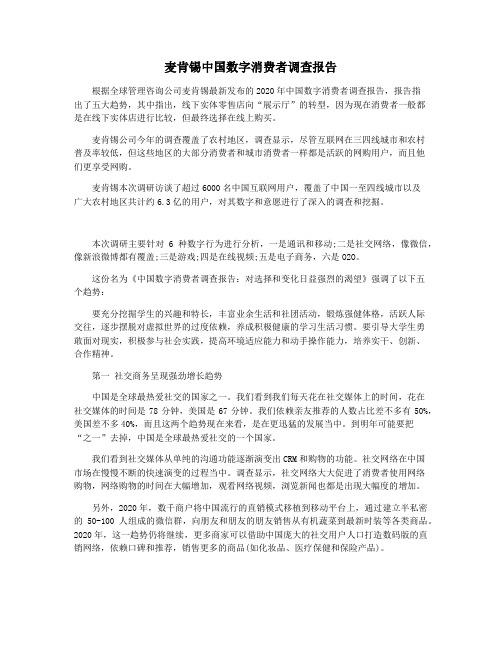
农村消费者其实他的互联网渗透率还不是那么高,很多人不一定有智能手机。但是我们看到像浙江桐庐县淘宝村店,在村里面有一间房子,里面有电脑,有宽带,村里组织会使用淘宝的人来为村民统一购买商品,他们“双十一”完成订单1229个,平均单店销售额11000元。
我们看到社交媒体从单纯的沟通功能逐渐演变出CRM和购物的功能。社交网络在中国市场在慢慢不断的快速演变的过程当中。调查显示,社交网络大大促进了消费者使用网络购物,网络购物的时间在大幅增加,观看网络视频,浏览新闻也都是出现大幅度的增加。
另外,2020年,数千商户将中国流行的直销模式移植到移动平台上,通过建立半私密的50-100人组成的微信群,向朋友和朋友的朋友销售从有机蔬菜到最新时装等各类商品。2020年,这一趋势仍将继续,更多商家可以借助中国庞大的社交用户人口打造数码版的直销网络,依赖口碑和推荐,销售更多的商品(如化妆品、医疗保健和保险产品)。
个人原因造成空巢老人。一是老人自己希望过独立生活,得到更多自由。这部分 老人大多是经济上能够独立,精神生活较为丰富,身体状况较好的低龄老人。二是老人对老居住地有深厚感情,即便是子女进了城或是迁了新居,要求其到新地居住生活,但他们不愿意离开久居的环境,有山有田有房子,坚持守着老根据地。
驻村以后,可能与我是师范生的缘故,我对本村的留守儿童问题十分关注。工作后积极调研,掌握分析情况,建立留守儿童档案。同时,积极参与本镇08届优秀大学生村官贾苑同志创办的留守儿童服务中心的关爱活动,现在在中心担任留守儿童的语文与数学的教辅工作。
零售行业的现状和发展趋势
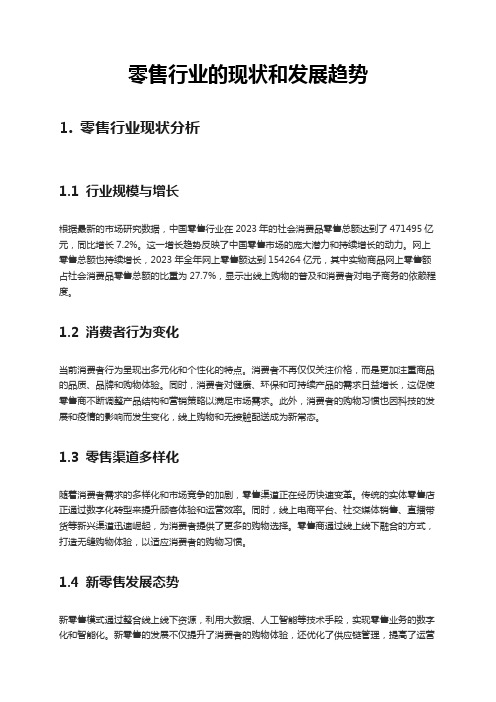
零售行业的现状和发展趋势1. 零售行业现状分析1.1 行业规模与增长根据最新的市场研究数据,中国零售行业在2023年的社会消费品零售总额达到了471495亿元,同比增长7.2%。
这一增长趋势反映了中国零售市场的庞大潜力和持续增长的动力。
网上零售总额也持续增长,2023年全年网上零售额达到154264亿元,其中实物商品网上零售额占社会消费品零售总额的比重为27.7%,显示出线上购物的普及和消费者对电子商务的依赖程度。
1.2 消费者行为变化当前消费者行为呈现出多元化和个性化的特点。
消费者不再仅仅关注价格,而是更加注重商品的品质、品牌和购物体验。
同时,消费者对健康、环保和可持续产品的需求日益增长,这促使零售商不断调整产品结构和营销策略以满足市场需求。
此外,消费者的购物习惯也因科技的发展和疫情的影响而发生变化,线上购物和无接触配送成为新常态。
1.3 零售渠道多样化随着消费者需求的多样化和市场竞争的加剧,零售渠道正在经历快速变革。
传统的实体零售店正通过数字化转型来提升顾客体验和运营效率。
同时,线上电商平台、社交媒体销售、直播带货等新兴渠道迅速崛起,为消费者提供了更多的购物选择。
零售商通过线上线下融合的方式,打造无缝购物体验,以适应消费者的购物习惯。
1.4 新零售发展态势新零售模式通过整合线上线下资源,利用大数据、人工智能等技术手段,实现零售业务的数字化和智能化。
新零售的发展不仅提升了消费者的购物体验,还优化了供应链管理,提高了运营效率。
例如,通过数据分析,零售商可以更准确地预测市场需求,实现库存的精细化管理。
同时,新零售也推动了零售业态的创新,如无人超市、智能货架等新型零售形式的出现,为消费者带来了更加便捷和个性化的购物体验。
2. 零售行业竞争格局2.1 主要零售企业分析在中国零售行业中,主要零售企业通过不断的创新和市场拓展,形成了各自的竞争优势。
以下是对部分主要零售企业的分析:●京东:作为中国领先的电商平台之一,京东以其高效的物流系统和优质的客户服务赢得了市场份额。
零售业的研究报告
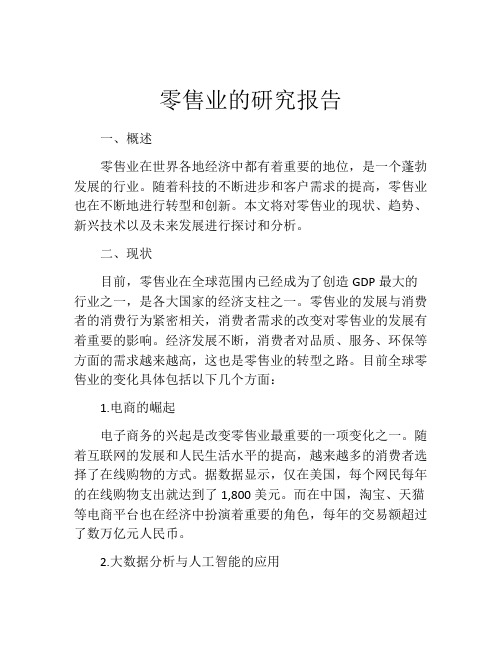
零售业的研究报告一、概述零售业在世界各地经济中都有着重要的地位,是一个蓬勃发展的行业。
随着科技的不断进步和客户需求的提高,零售业也在不断地进行转型和创新。
本文将对零售业的现状、趋势、新兴技术以及未来发展进行探讨和分析。
二、现状目前,零售业在全球范围内已经成为了创造GDP最大的行业之一,是各大国家的经济支柱之一。
零售业的发展与消费者的消费行为紧密相关,消费者需求的改变对零售业的发展有着重要的影响。
经济发展不断,消费者对品质、服务、环保等方面的需求越来越高,这也是零售业的转型之路。
目前全球零售业的变化具体包括以下几个方面:1.电商的崛起电子商务的兴起是改变零售业最重要的一项变化之一。
随着互联网的发展和人民生活水平的提高,越来越多的消费者选择了在线购物的方式。
据数据显示,仅在美国,每个网民每年的在线购物支出就达到了1,800美元。
而在中国,淘宝、天猫等电商平台也在经济中扮演着重要的角色,每年的交易额超过了数万亿元人民币。
2.大数据分析与人工智能的应用现在的零售业发展越来越注重数据分析,以及人工智能技术的应用。
通过大数据分析,零售业可以准确的了解消费者的需求,并根据消费者的购买行为将商品有针对性地展示给消费者。
而利用人工智能技术,零售业可以将客户服务更加智能化,顺畅、快速地解决客户问题和需求,提升了客户服务的质量和效率。
3.多渠道销售在零售业的发展过程中,多渠道销售变得越来越受重视,即在不同的销售平台上开展销售以获得更广阔的市场。
目前零售业包括线上、线下、社交媒体等不同销售平台,零售商通过多个销售渠道来满足消费者的需求。
三、趋势1. 店内技术化未来一些实体店将会采用更多的技术,以提供更好的购物体验。
可能会有虚拟导购机器人,可以为顾客提供帮助,高科技互动窗口和全息展示等。
这些技术将有助于比较消费者需求和购物需求之间的区别,帮助零售商更好地了解消费者,并提供更准确的产品和服务。
2. 个性化和可定制化消费者需求的多样化,将让个性化和可定制化成为零售业的一个趋势。
透视麦肯锡在华的战略错误现象-王府井百货案例分析与点评
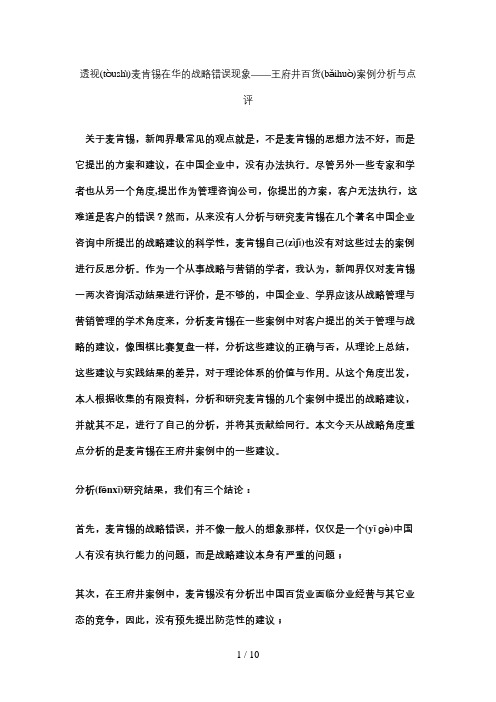
透视(tòushì)麦肯锡在华的战略错误现象——王府井百货(bǎihuò)案例分析与点评关于麦肯锡,新闻界最常见的观点就是,不是麦肯锡的思想方法不好,而是它提出的方案和建议,在中国企业中,没有办法执行。
尽管另外一些专家和学者也从另一个角度,提出作为管理咨询公司,你提出的方案,客户无法执行,这难道是客户的错误?然而,从来没有人分析与研究麦肯锡在几个著名中国企业咨询中所提出的战略建议的科学性,麦肯锡自己(zìjǐ)也没有对这些过去的案例进行反思分析。
作为一个从事战略与营销的学者,我认为,新闻界仅对麦肯锡一两次咨询活动结果进行评价,是不够的,中国企业、学界应该从战略管理与营销管理的学术角度来,分析麦肯锡在一些案例中对客户提出的关于管理与战略的建议,像围棋比赛复盘一样,分析这些建议的正确与否,从理论上总结,这些建议与实践结果的差异,对于理论体系的价值与作用。
从这个角度出发,本人根据收集的有限资料,分析和研究麦肯锡的几个案例中提出的战略建议,并就其不足,进行了自己的分析,并将其贡献给同行。
本文今天从战略角度重点分析的是麦肯锡在王府井案例中的一些建议。
分析(fēnxī)研究结果,我们有三个结论:首先,麦肯锡的战略错误,并不像一般人的想象那样,仅仅是一个(yīɡè)中国人有没有执行能力的问题,而是战略建议本身有严重的问题;其次,在王府井案例中,麦肯锡没有分析出中国百货业面临分业经营与其它业态的竞争,因此,没有预先提出防范性的建议;其三,王府井没有分析出,百货连锁业作为一种业态,在全球生存发展的核心竞争能力问题,有明显的误导影响。
对比王府井与国美电器:1998到2002年据历史资料显示,王府井在1998年、1999年均是负增长,其中,王府井在1999年的增长幅度-28.2%,2000年之后,王府井才开始恢复元气,实现其持续增长的目标。
这个我们不能不说麦肯锡的战略方案存在重大问题,有人可能会说这是中国人执行力的问题,但实际情况呢?我们来回忆一下中国零售业在1998年的市场整体增长情况,1998年中国的零售业是什么样子?回顾1998年中国的零售商业,总结出主要的特点有三:--兼并重组成为业界主打潮流--国际连锁企业在中国攻城略地--专业连锁应时而出业绩非凡第一、兼并连锁。
麦肯锡研究报告:中国零售银行业需建立八大转型能力
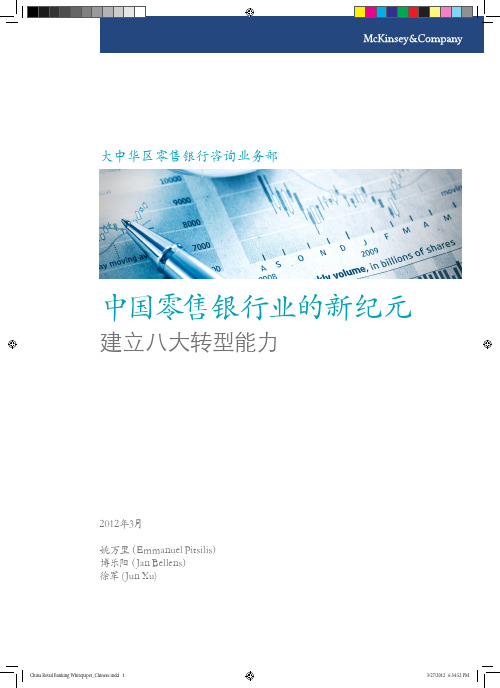
中国零售银行业的新纪元建立八大转型能力打造八大转型能力新的市场环境要求不同以往的业务模式。
需要能够实现三大战略目标:更聪明和更有针对性的方式获取客户式。
为达到这些验和运营效率,经验和国内能否建立和巩固它们将是未来一家零售银行成败的关键资料来源:麦肯锡中国个人金融服务调研资料来源:麦肯锡分析管理客户,提升价值用更低的成本来改善客户服务优化组织和人才体系管理资本和资金有效性打造八大转型能力Next generation retail banking in China Building eight transformational capabilitiesMarch 2012China 2000China 2011China 2020New battlefield:Building next generation bank with customerorientation and distin-ctive capabilities ▪Land grab to secure ▪Diversifying consumer needs ▪Rising competition ▪Focus on network expansion ▪Product-push approachBUILDING EIGHT TRANSFORMATIONAL CAPABILITIESThe new market realities call for a different model that could fulfill three strategic objectives: building more profitable and sustainable primary relationships,carrying out smarter and more focused customer acquisition, and developing a low-cost and scalable operating model. To achieve these objectives, Chinese banks must build capabilities to manage customer for value, improve customer experiences and operational efficiency, build organization enablers, as well as manage capital and funding efficiency. We have identified eight transformational capabilities that will set the winners apart from the losers. (Exhibit 9)Exhibit 9SOURCE: McKinsey China personal financial services survey 2011High SOURCE: McKinsey analysisAdvance organization and people Deliver better customer service at lower cost Manage customer for value Manage capital and funding efficiencyBuilding 8 transformational capabilities。
中国零售业面临第三次挑战及其应对思路
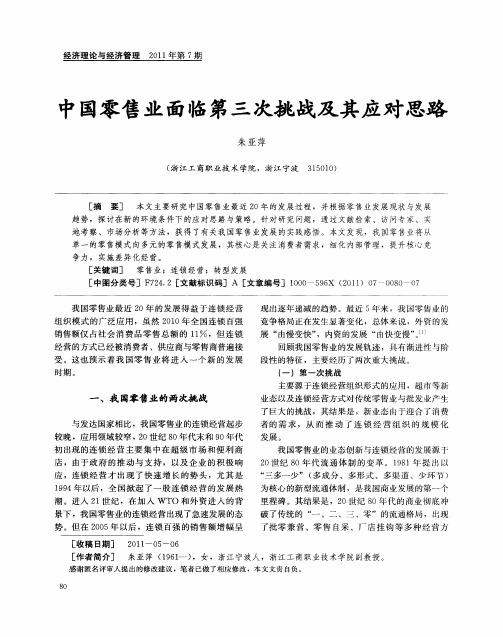
[ 关键 词 ] 零售 业 ;连 锁 经营 ;转 型发展
[ 中图分类号]F 2. 文献标识码]A [ 742[ 文章编号]10 -5 6 (0 1 7 ( 8 0 0 0 9X 2 1)0 ) 0 7 ( )
我 国零 售业 最 近 2 0年 的发展 得 益 于连 锁 经 营
潮 。进入 2 纪 ,在 加 入 W T 和外 资 进 入 的 背 1世 O 景下 ,我 国零 售业 的连锁 经 营 出现 了急 速发 展 的态 势 。但在 20 05年 以后 ,连 锁 百强 的销 售 额 增 幅 呈 [ 收稿 日期] 2 1 —0 —0 01 5 6
里程碑 。其结果是,2 世纪 8 年代的商业彻底 冲 0 0
21 0 1年第 7期
中国零售业 面临第三 次挑 战及其应对 思路
朱 亚 萍
( 江工商职 业技 术 学院 ,浙 江宁波 浙 3 51 ) 1 0 0
[ 摘 要 ] 本 文主要 研 究 中国零 售 业最 近 2 0年 的发展过 程 ,并根 据零 售 业发展 现状 与发展 趋 势 ,探讨在 新 的环境 条件 下 的应对 思路 与策 略 。针 对研 究问题 ,通过 文 献检 索 、访 问专 家 、实 地 考察 、 市场分 析等 方法 ,获得 了有关我 国零 售 业发展 的 实践感 悟 。本 文发 现 ,我 国零售 业将 从 单 一 的零售模 式 向多元 的零 售模 式发 展 ,其核 心是 关注 消 费者 需求 ,细化 内部 管理 ,提升 核心 竞
发展。
与发 达 国家相 比,我 国零 售业 的连 锁经 营起 步
较 晚 ,应 用领 域较 窄 ,2 0世纪 8 0年代 末 和 9 年 代 0
初 出现 的连 锁 经 营 主要 集 中 在 超 级 市 场 和 便 利 商
中国零售行业的现状和发展前景分析

中国零售行业的现状和发展前景分析中国零售行业的现状和发展前景分析引言:随着经济的快速发展和人民生活水平的提高,中国零售行业迎来了黄金发展时期。
本文将分析中国零售行业的现状和未来发展前景。
一、中国零售行业的现状1. 市场规模庞大:中国是世界上最大的消费市场之一,消费人口众多,年轻人占比较高,消费潜力巨大。
2. 区域发展不平衡:中国各地区经济发展水平不一,东部沿海地区大城市的零售业较为发达,中西部城市和农村地区发展相对滞后。
3. 经营模式多样化:中国零售业涉及超市、百货、便利店、电商、直播带货等多种经营模式,竞争激烈。
4. 人力资源问题:零售业从业人员普遍素质较低,管理水平较差,人力资源短缺成为制约行业发展的因素之一。
二、中国零售行业的发展前景1. 外资进入:随着中国市场对外开放程度的加大,越来越多的外国零售企业进入中国市场,带来了新的竞争力和管理经验。
2. 电商快速发展:中国的电商市场规模庞大,线上线下融合发展的模式也越来越成熟,电商将继续保持快速发展。
3. 农村市场潜力大:中国农村人口众多,消费潜力巨大,农村市场的开发前景广阔。
4. 跨境电商的崛起:跨境电商在中国市场越来越受欢迎,进口商品供应链的完善将促进跨境电商的持续发展。
5. 新型消费需求的崛起:随着消费者需求的升级和变化,绿色、健康、高品质、个性化定制等需求逐渐增加,优质零售企业将获得更多机遇。
6. 技术革新的推动:人工智能、物联网、大数据等新技术在零售业的应用将为零售企业提供更多的发展机遇和市场竞争力。
三、中国零售行业发展面临的挑战1. 高房租和人力成本:中国的高房租和人力成本是零售企业发展的主要瓶颈之一,特别是在一线和发达城市。
2. 供应链问题:中国零售业的供应链承担了较大的压力,整合供应链、降低成本是零售企业发展的重要任务。
3. 品牌建设和差异化竞争:品牌建设是零售企业发展的重要环节,如何提升品牌影响力,打造差异化竞争优势是亟待解决的问题。
零售行业的现状和发展趋势

零售行业的现状和发展趋势1. 行业现状分析1.1 市场规模与增长趋势中国零售行业在近年来经历了快速的发展,市场规模持续扩大。
根据艾媒咨询发布的《2023-2024年中国零售行业发展趋势报告》,2012-2023年间,中国仓储会员超市行业市场规模始终保持在200亿元以上,2023年同比增长8.7%。
便利店行业市场规模在2022年达到4237亿元,同比增长10.5%,而2023年零食集合店市场规模为809亿元。
这些数据表明,新零售相关市场规模持续飙升,市场提升空间较大。
尼尔森IQ发布的《2024 中国零售业发展报告》也指出,中国零售市场正逐渐从消费升级模式转向性价比导向的新纪元,消费升级与降级现象并存,消费者的多元化需求为市场带来了结构性增长的机会。
报告中提到,2023年中国快消品零售市场虽整体销售额同比2022年微跌0.04%,但线上渠道中内容电商的销售额同比大幅增长55.9%,线下渠道中便利店实现3.9%的增长。
1.2 消费者行为变化随着社会物质生活的丰富,消费者购物的关注点不再局限于产品的品质,逐渐对个性化的产品和服务展现出越来越多的需求。
艾媒咨询的调研数据显示,61.5%的消费者表示日常生活、工作附近购物方便,办理仓储超市会员卡意义不大;61.4%的消费者表示选择零食集合店的原因是丰富的商品种类;一二线城市中超7成消费者选择前往连锁型便利店进行消费。
这反映出消费者日常对连锁新型便利店更为青睐。
尼尔森IQ的调研结果也显示,中国消费者在2023年将提升对于生鲜产品/健康保障类产品的消费,重点关注新鲜果蔬、乳制品、生鲜肉类的购买。
消费者在商品购买和渠道选择上更为明智和慎重,产品的品质和功能仍是未来维系消费者的基石。
1.3 技术革新与应用零售行业的技术革新在近年来取得了显著的进展,尤其是在人工智能、大数据、云计算等技术的应用上。
2023年,人工智能应用在零售行业取得巨大突破并开始广泛引用,包括商品数字化、会员运营、智能客服、商品知识库、图像处理、营销等方面。
零售业市场准入与发展我国零售业的对策
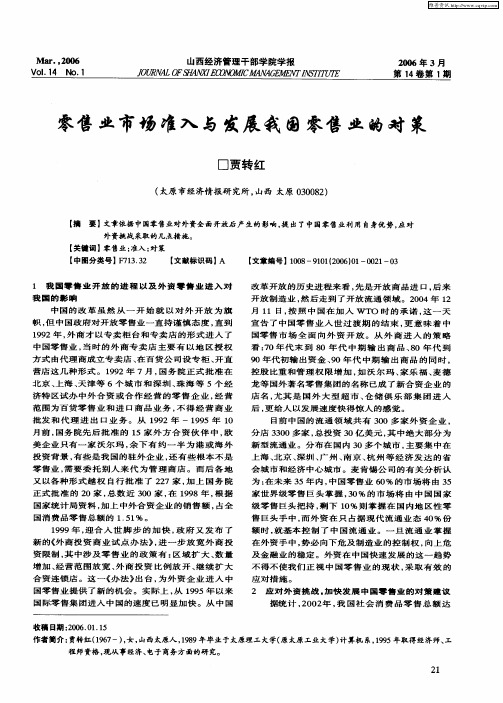
零售 业市场 准入 与发展 我 国零售 业的对 策
L 贾 千 三- 口J 转 红 _ J 贝
( 太原 市经 济情报研 究所 , 西 太原 0 08 ) 山 30 2
【 要】 摘 文章依据中国零售业对外资全面开放后产生的影响, 出了中国零售业利用 自身优势, 提 应对
外资挑战采取 的几 点措施 。
【 关键词】 零售业; 准入; 对策 【 中图分类号 】 733 F1. 2 【 文献标识码】 A 【 文章编号】 08 90 {060 — 0 1 0 10 — 1120 )1 02 — 3
改 革开 放 的历史 进程 来看 , 是开 放商 品进 口, 来 先 后
开 放制 造业 , 后走 到 了开放 流通 领 域 。20 然 0 4年 1 2 月 1 日 , 照 中 国 在 加 入 W TO 时 的 承 诺 , 一 天 1 按 这
控 股 比重 和管 理 权 限增 加 , 沃 尔 玛 、 乐 福 、 德 如 家 麦
龙 等 国 外 著 名 零 售 集 团 的 名 称 已成 了 新 合 资 企 业 的 店名 , 其 是 国外 大 型 超 市 、 储 俱 乐 部 集 团 进 入 尤 仓
后 , 给 人 以发 展 速 度 快 得 惊 人 的 感 觉 。 更 目前 中 国 的 流 通 领 域 共 有 3 0 多 家 外 资 企 业 , 0
维普资讯
Ma .0 r. 2 06
山西经 济管 理 干部学院 学报
J O A F OLe LO N I Ⅸ l N l l I cMA AG E、 N 疆 H E
V I 1 N . o.4 o 1
20 0 6年 3月 第 1 第 1 4卷 期
1 我 国零 售 业 开 放 的进 程 以及 外 资 零 售 业 进 入对 我 国 的 影 响
零售行业数据分析报告

零售行业数据分析报告一、绪论零售行业是一个充满竞争的市场,企业需要了解市场趋势和消费者需求,以便制定有效的市场营销策略。
本报告将通过对零售行业数据的分析,揭示当前市场状况并提供有关发展方向的建议。
二、市场规模与增长趋势根据我们的数据分析,零售行业在过去几年保持稳定增长。
根据最新的统计数据,零售行业市场规模达到X万亿元,同比增长X%。
在消费升级和经济发展的推动下,零售行业仍然具有较大的增长潜力。
三、消费者行为分析1. 消费者人群:从数据中我们可以看到,年轻消费者在零售行业中占据主导地位。
他们更加注重品牌、品质和个性化的购物体验。
2. 购物渠道:线上购物在零售行业中快速崛起,已成为重要的销售渠道。
不过,实体店仍然是消费者中首选购物方式,尤其是对于需要亲自试穿或触摸产品的购物者来说。
3. 消费决策:消费者的购买决策受多种因素影响,包括产品价格、品牌声誉、产品质量以及促销活动等。
纵向对比分析数据进一步显示了消费者倾向于购买有优惠券或提供快速配送服务的产品。
四、竞争对手分析通过对竞争对手的数据分析,我们发现市场上的主要竞争对手有ABC公司、DEF公司和GHI公司。
ABC公司作为市场领导者,其高品质和广泛的产品线是其竞争优势。
DEF公司以价格低廉著称,吸引了中低收入人群。
GHI公司则专注于独特的产品设计和创新营销策略。
五、发展机遇与挑战1. 机遇:随着技术的进步,电子商务平台持续发展,为零售行业提供了全新的销售渠道。
此外,消费升级以及新兴市场需求的增加也为零售行业带来了机会。
2. 挑战:竞争日趋激烈,产品同质化现象更加突出。
此外,物流成本的增加以及消费者对环保产品和可持续发展的需求也是零售行业面临的挑战。
六、发展建议基于以上数据分析结果,我们提出以下发展建议:1. 加强市场营销策略,提高品牌知名度和竞争力。
2. 加大在线销售渠道的投入,提供更好的用户体验。
3. 提高产品质量和创新能力,以吸引消费者。
4. 加强与供应商和物流公司的合作,优化物流效率,降低成本。
中国零售行业现状分析
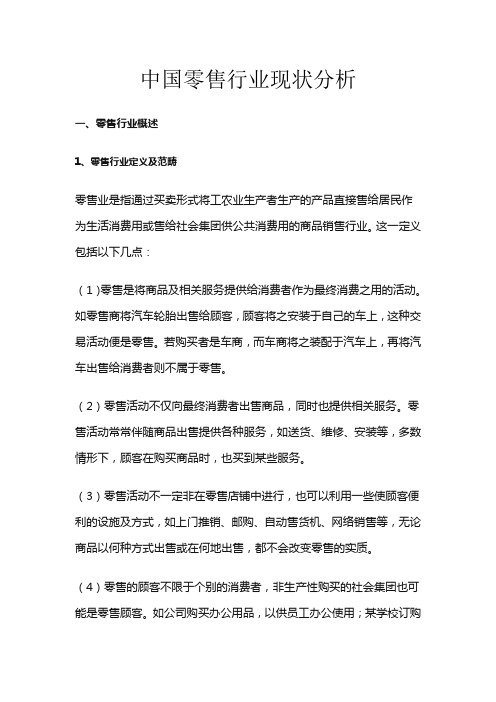
中国零售行业现状分析一、零售行业概述1、零售行业定义及范畴零售业是指通过买卖形式将工农业生产者生产的产品直接售给居民作为生活消费用或售给社会集团供公共消费用的商品销售行业。
这一定义包括以下几点:(1)零售是将商品及相关服务提供给消费者作为最终消费之用的活动。
如零售商将汽车轮胎出售给顾客,顾客将之安装于自己的车上,这种交易活动便是零售。
若购买者是车商,而车商将之装配于汽车上,再将汽车出售给消费者则不属于零售。
(2)零售活动不仅向最终消费者出售商品,同时也提供相关服务。
零售活动常常伴随商品出售提供各种服务,如送货、维修、安装等,多数情形下,顾客在购买商品时,也买到某些服务。
(3)零售活动不一定非在零售店铺中进行,也可以利用一些使顾客便利的设施及方式,如上门推销、邮购、自动售货机、网络销售等,无论商品以何种方式出售或在何地出售,都不会改变零售的实质。
(4)零售的顾客不限于个别的消费者,非生产性购买的社会集团也可能是零售顾客。
如公司购买办公用品,以供员工办公使用;某学校订购鲜花,以供其会议室或宴会使用。
所以,零售活动提供者在寻求顾客时,不可忽视团体对象。
在中国,社会集团购买的零售额平均达10%左右。
此外,比较主流的零售业定义还有两种:一种是营销学角度的定义:认为零售业是任何一个处于从事由生产者到消费者的产品营销活动的个人或公司,他们从批发商、中间商或者制造商处购买商品,并直接销售给消费者。
这种定义在近三十年的营销学的文献中非常普遍。
另一种是美国商务部的定义:零售贸易业包括所有把较少数量商品销售给普通公众的实体。
他们不改变商品的形式,由此产生的服务也仅限于商品的销售。
零售贸易板块不仅包括了店铺零售商而且包括了无店铺零售商。
2、零售业态分类及特点零售业态是指零售企业为满足不同的消费需求进行相应的要素组合而形成的不同经营形态,零售业态从总体上可以分为有店铺零售业态和无店铺零售业态两大类。
就商人主体而言,它是商人针对某一目标市场所选择的体现商人意向和决策的商店。
我国零售业与国外的差距及其改善措施
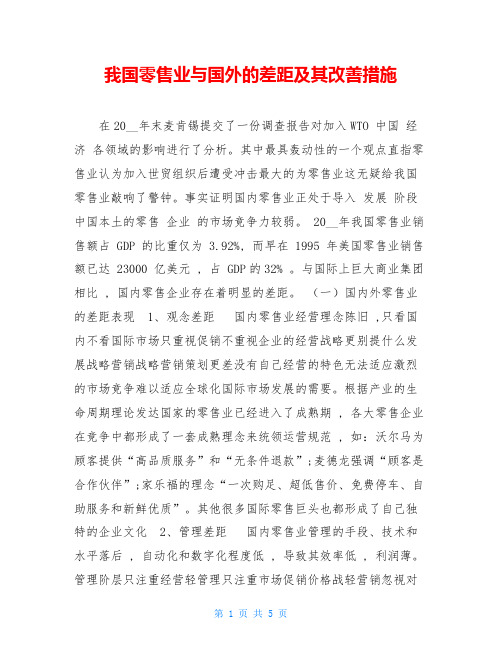
我国零售业与国外的差距及其改善措施在20__年末麦肯锡提交了一份调查报告对加入WTO 中国经济各领域的影响进行了分析。
其中最具轰动性的一个观点直指零售业认为加入世贸组织后遭受冲击最大的为零售业这无疑给我国零售业敲响了警钟。
事实证明国内零售业正处于导入发展阶段中国本土的零售企业的市场竞争力较弱。
20__年我国零售业销售额占 GDP 的比重仅为 3.92%, 而早在 1995 年美国零售业销售额已达 23000 亿美元 , 占 GDP的32% 。
与国际上巨大商业集团相比 , 国内零售企业存在着明显的差距。
(一)国内外零售业的差距表现 1、观念差距国内零售业经营理念陈旧 ,只看国内不看国际市场只重视促销不重视企业的经营战略更别提什么发展战略营销战略营销策划更差没有自己经营的特色无法适应激烈的市场竞争难以适应全球化国际市场发展的需要。
根据产业的生命周期理论发达国家的零售业已经进入了成熟期 , 各大零售企业在竞争中都形成了一套成熟理念来统领运营规范 , 如:沃尔马为顾客提供“高品质服务”和“无条件退款”;麦德龙强调“顾客是合作伙伴”;家乐福的理念“一次购足、超低售价、免费停车、自助服务和新鲜优质”。
其他很多国际零售巨头也都形成了自己独特的企业文化 2、管理差距国内零售业管理的手段、技术和水平落后 , 自动化和数字化程度低 , 导致其效率低 , 利润薄。
管理阶层只注重经营轻管理只注重市场促销价格战轻营销忽视对经营战略的研究忽视企业战略的管理从而导致企业没有远景规划发展战略不明管理混乱效率低下。
与其相反的事进入中国的零售外商个个都具备先进的管理经验和营销技巧、长远的经营目标、完善的市场组织和高效的运作体系对商品的管理、服务的管理、价格的管理、现场的管理、设备的管理都有独到的地方远远优于国内零售企业。
3、规模差距由于长期以来市场体系的欠缺和企业自有资金薄弱技术能力不足导致国内零售企业规模普遍偏小 , 市场集中度低 , 无法获取规模效益。
零售业区域优势比较分析报告
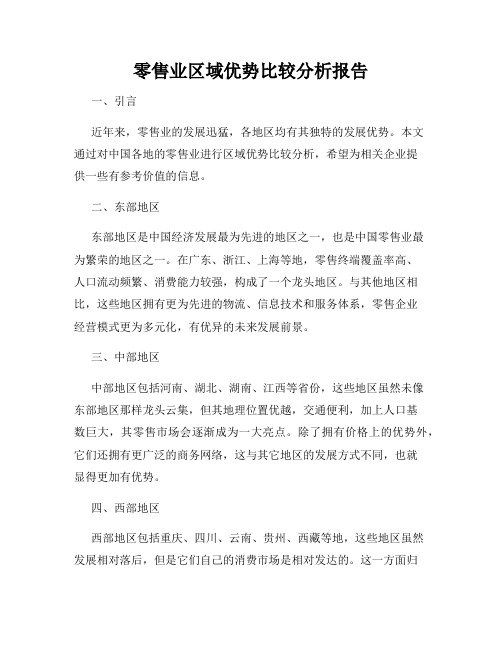
零售业区域优势比较分析报告一、引言近年来,零售业的发展迅猛,各地区均有其独特的发展优势。
本文通过对中国各地的零售业进行区域优势比较分析,希望为相关企业提供一些有参考价值的信息。
二、东部地区东部地区是中国经济发展最为先进的地区之一,也是中国零售业最为繁荣的地区之一。
在广东、浙江、上海等地,零售终端覆盖率高、人口流动频繁、消费能力较强,构成了一个龙头地区。
与其他地区相比,这些地区拥有更为先进的物流、信息技术和服务体系,零售企业经营模式更为多元化,有优异的未来发展前景。
三、中部地区中部地区包括河南、湖北、湖南、江西等省份,这些地区虽然未像东部地区那样龙头云集,但其地理位置优越,交通便利,加上人口基数巨大,其零售市场会逐渐成为一大亮点。
除了拥有价格上的优势外,它们还拥有更广泛的商务网络,这与其它地区的发展方式不同,也就显得更加有优势。
四、西部地区西部地区包括重庆、四川、云南、贵州、西藏等地,这些地区虽然发展相对落后,但是它们自己的消费市场是相对发达的。
这一方面归功于这里的消费模式与文化氛围,另一方面则是因为这里的消费者认同本地企业的产品和服务。
同时,这些地区也注重打造自己的特色产业,提高自身的竞争力。
五、北部地区北部地区包括北京、天津、山西等地,这些地区的零售业相对于其他地区起步较晚,但目前已经取得了很大的进展。
值得注意的是,这些地区拥有更为高层次的人才和更为完善的产业链,同时这个地区的经济发展、对零售业的支持程度也是非常高的。
六、结论综上所述,无论是东部、中部、西部还是北部地区,每个地区都具有其独特的零售业发展优势。
零售企业通过对这些优势进行利用,借鉴各进阶地区的先进经验,可以更好地开拓市场,提高企业的盈利能力和市场竞争力。
关于外资企业进入中国零售业的分析
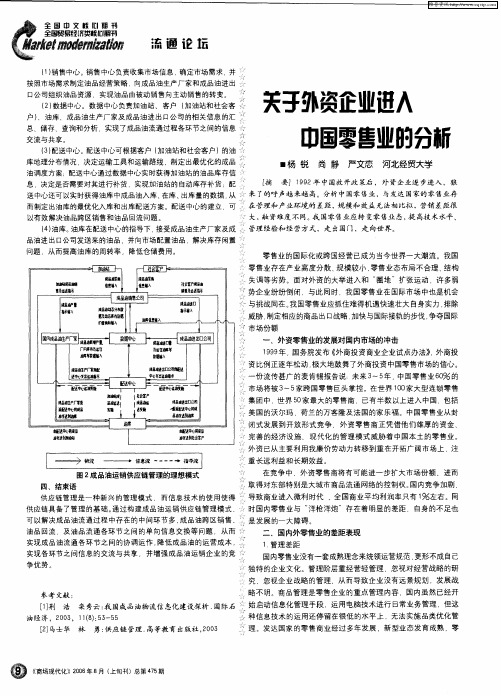
i 通 论 坛 i ; i
( ) 售中心 。 1销 销售 中心 负责 收集市 场 信 息 . 定市 场需 求 . 确 并
按照市场需求制定油品经营策略.向成品油生产厂家和成品油进出
口公 司组 织油 品资 源 实现 油 品由被 动 销 售 向主 动销 售 的转 变 。 ( ) 据 中心 。数 据 中心 负 责加 油站 、客 户 ( 油站 和社 会 客 2数 加 户) 、油 库 、成 品油 生产 厂 家及 成 品 油进 出 口公 司的 相 关信息 的汇
大幅度降低管理 成本 , 坚持微利原则 . 益 :加上管理水平落后 ,服务质量较差 .在市场经济 的洪流重缺 连锁业只有具备规模 经营 .
乏战斗力。许多企业尤其 是中/ 企业在其 中竞争 .没有任何企业 才能实现向顾客提供 低价 格、高质量商品。我国的零售业都是市 J 、
占据显著的市 场份额 . 也没有任何一个企 业能对整个产业 的发展 场集 中度低 、 规模小 、 分散 经营。 尽管近几年 国内商界 的也在 ” 上 产生重大的影 响。 规模偏小的缺点致使我 国零售企业采购成本 高 . 规模 .上水平 ”上做 了较大努力 .可经 营战略和规模 要考虑规模
2 产业 环 境 差பைடு நூலகம்距
品牌管理技术 .人力资源
中国 的零售业应向外资零售 商学习规范 性的服务 . 因此 .国内只有提高商品管理 水平 .运用现代化技术 .才能培养 管理技术等等。 .
克服短期行 为和过分功利化倾 向.真正实现 ” 顾客是上 帝”的理
念。
我国的零售业是一种典 型的零散型产业 .又可称为原子 型产 业. 这就 限制 了零售企业的客户数量 . 限制了企 业规模 的扩大 。 也
零售业的国际化或跨国经营 已成 为当今世界一 大潮流 。我国 :零售业存在产业高度分散 、 规模较小 , 零售 业态布局不合理 、 结构
零售行业数据分析报告
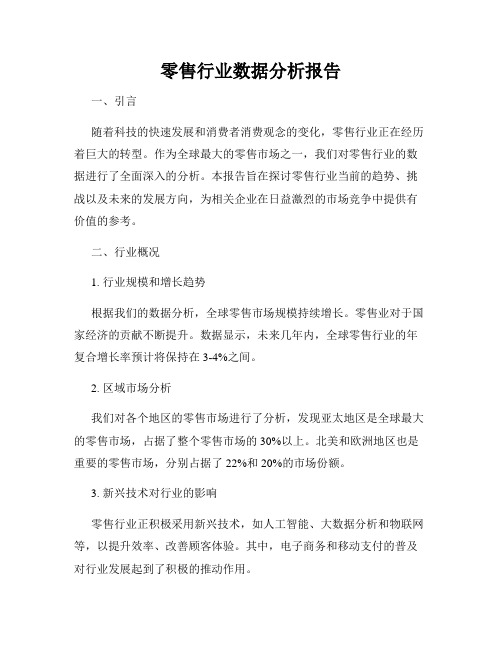
零售行业数据分析报告一、引言随着科技的快速发展和消费者消费观念的变化,零售行业正在经历着巨大的转型。
作为全球最大的零售市场之一,我们对零售行业的数据进行了全面深入的分析。
本报告旨在探讨零售行业当前的趋势、挑战以及未来的发展方向,为相关企业在日益激烈的市场竞争中提供有价值的参考。
二、行业概况1. 行业规模和增长趋势根据我们的数据分析,全球零售市场规模持续增长。
零售业对于国家经济的贡献不断提升。
数据显示,未来几年内,全球零售行业的年复合增长率预计将保持在3-4%之间。
2. 区域市场分析我们对各个地区的零售市场进行了分析,发现亚太地区是全球最大的零售市场,占据了整个零售市场的30%以上。
北美和欧洲地区也是重要的零售市场,分别占据了22%和20%的市场份额。
3. 新兴技术对行业的影响零售行业正积极采用新兴技术,如人工智能、大数据分析和物联网等,以提升效率、改善顾客体验。
其中,电子商务和移动支付的普及对行业发展起到了积极的推动作用。
三、消费者行为分析1. 购物渠道选择随着电子商务的兴起,越来越多的消费者选择在线购物。
我们的数据显示,电子商务渠道的销售额在过去几年内呈现持续增长的趋势。
但是,实体店依然是许多消费者购物的首选。
2. 顾客忠诚度和体验顾客忠诚度和良好的购物体验对零售行业至关重要。
零售商通过提供个性化推荐、便捷的购物流程和及时的售后服务等方式,来增强顾客的忠诚度和购物体验。
3. 数据驱动的个性化营销通过大数据分析和智能算法,零售商能够实现个性化的营销策略。
我们的数据显示,个性化营销能够极大地提高销售额和顾客满意度。
四、供应链管理与物流分析1. 供应链优化供应链管理对于零售行业非常重要。
优化供应链能够降低成本、提高效率,并且能够更好地满足顾客需求。
通过数据分析,零售商能够预测销售量、优化库存和减少运输时间等。
2. 物流模式转变随着电子商务的兴起,物流模式正发生着巨大的变革。
快递、配送和仓储等环节的改进,对于提高物流效率和降低成本至关重要。
Tesco和Wal-Mart的最新报告及其在中国的运营

Tesco和Wal-Mart的最新报告及其在中国的运营2004年12月11日,对于中国乃至世界的零售商来说,这都是一个不同寻常的日子。
根据入市承诺,从这一天开始,中国政府将取消外资零售业在中国的投资限制,同样在这一年,排名世界第三的零售巨头Tesco特易购通过收购顶新集团旗下子公司顶超控股50%的股份,借助乐购的壳子进入了中国市场。
然而在16年之后,一切如同黄粱一梦,麦肯锡报告曾在中国加入WTO后预言,未来3-5年中国的零售业市场,60%的份额属于3-5家世界级巨头,可惜来势汹汹的Tesco 特易购不仅没能位列其中,如今十多年过去,在这个厮杀无比激烈的市场,早已没有它的容身之所。
我们先来回顾当初被称作打响外资收购中国超市第一枪的收购案。
交易双方是英国零售龙头企业Tesco特易购和顶新集团,他们的交易顾问分别是摩根士丹利和JP摩根。
1998年,顶新在中国大陆开了第一家乐购超市。
此后6年,乐购的门店扩张到25家。
2003年,乐购销售额为3.3亿英镑,净利润550万英镑。
2004年7月14日,Tesco 经过2-3年对中国市场的考察和长达半年的谈判,最终以1..4亿英镑的高价收购了顶新集团子公司顶新控股50%的股份,至此,零售业三巨头(特易购,沃尔玛、家乐福)在中国彻底开放市场前齐聚中国,再加上虎视眈眈的泰国,韩国和日本零售商以及一众担惊受怕的国产品牌,一场大战在所难免。
根据乐购财报,Tesco特易购这1.4亿英镑再过十年也很难收回本,但是考虑到中国城镇化带来的巨大市场和其他品牌的先发制人,Tesco已经无法继续等待。
当时,沃尔玛和家乐福在中国分别拥有41和33家门店。
在零售业竞争最激烈的上海,乐购的客户忠诚度排名第一,消费者购买频次排名第一,每次消费金额为27元,排名第三。
于是,Tesco在易初莲花、好又多和乐购之间最终选择了后者,将1.4亿英镑全数付给顶新集团后,他们没有要求乐购更改标识,而是继续用这个名字抢占市场。
- 1、下载文档前请自行甄别文档内容的完整性,平台不提供额外的编辑、内容补充、找答案等附加服务。
- 2、"仅部分预览"的文档,不可在线预览部分如存在完整性等问题,可反馈申请退款(可完整预览的文档不适用该条件!)。
- 3、如文档侵犯您的权益,请联系客服反馈,我们会尽快为您处理(人工客服工作时间:9:00-18:30)。
To make money from the expansion of the Chinese market, most oil companies will have to sell much more than gasoline. JONATHAN R. WOETZELThe McKinsey Quarterly, 2002 Number 3C C hina抯automotive market is predicted to be the third largest in the world by 2008.1 The accompanying growth in demand for gasoline and related car fuel products梒ombined with government plans to deregulate the sector and the need to address the chronic inefficiency of current distribution梥hould create a juicy opportunity for multinational oil companies as well as for China抯two domestic giants, PetroChina and Sinopec.Gasoline reaches the huge Chinese market through a fragmented retail and distribution network of about 90,000 stations, almost all state owned. Many are run more as sinecures than as businesses, often with a staff four to five times larger than the international norm but with less than a quarter of the average gasoline throughput of US stations. The Chinese government, which is well aware of the problem, has resolved not to allow the country抯energy infrastructure to burden the whole economy: it is fast deregulating the sector, which will be fully opened up to foreign companies in 2004 under the commitments attending the country抯membership in the World Trade Organization (WTO). Foreign oil companies have hitherto been restricted to one-off local deals in special economic zones or tied to investments in toll-road construction.Although the stage should thus be set for canny corporations to move into the market, it remains unclear how they will make money. Competition is already driving down retail margins on gasoline, while prices for the best station sites have soared as China抯large domestic oil companies have rushed to buy them. Oil companies in the West facing similar margin pressures know that most gasoline stations are viable only if they offer general-retail facilities at least as large as a convenience store, in addition to gasoline. This is true in China as well. The highest-volume sites might be made profitable on their fuel revenues alone, but the rest need substantial nonfuel revenues to make a profit.The strategic implications are clear. In China as elsewhere, the first decision for an oil company is whether to own and operate sites or merely to supply them with gasoline. If the company opts for ownership, it has a choice: to adopt a retail strategy and pursue nonfuel revenues from a portfolio of retail sites or to target only the highest-volume sites, using them to build a high-quality gasoline brand that can also be offered through independent retailers. At present, the Chinese oil majors are pursuing neither strategy; they have simply rushed to grab any available site, where they sell as much petroleum-based product as possible while ignoring the retail potential. The multinationals have been more judicious in selecting sites for their initial joint ventures, but they too have neglected the strategic choice. Unless all of these companies, domestic and international alike, change tack, their investments in expensive Chinese real estate may unravel.THE MARKET AND SITE ECONOMICSChina抯dominant oil companies are Sinopec, in the south and east, and PetroChina, which has the more comprehensive refinery and distribution network of the two, in the north and west (Exhibit 1). The two companies aim to capture, between them, 70 percent of China 抯gasoline sales volume by 2005. Since their IPOs, in 2000, they have invested heavily in petroleum-related infrastructure and in brand building. Having already raised their share of sales to more than 40 percent and secured most of the prime sites in the biggest cities, they are on track to meet this target.Until 2004, multinational companies will be allowed to own outright only the 300 or so sites they now possess through local deals struck before government deregulation of foreign investment in the sector, in the mid-1990s, but they can build up their holdings through joint ventures with Chinese companies. BP, ExxonMobil, and Royal Dutch/Shell are establishing joint ventures with PetroChina and Sinopec by contributing capital for the purchase of sites and by supplying higher-margin premium fuels; BP and PetroChina, for example, aim to boost their holdings to 950 stations by acquiring 670 stations from local companies in Fujian and Guangdong. Such joint ventures bind the partners only in specific provinces and have so far been formed in just 4 out of 27 of them. For the remainder, the options of both parties are still open.The 60 percent of sales not controlled by the two Chinese leaders is currently held by various quasi-governmental entities, including local and provincial authorities and state-owned enterprises. City governments, for example, have started their own retailing groups, often built around local highway-construction projects. Some private operators are also emerging: for example, China Resources Enterprise, a holding company based in Hong Kong, has 23 stations and is thinking about opening more. But in general, smaller companies, daunted by the bidding power of PetroChina and Sinopec, are holding back.Both of the majors hope that their spending will create a profitable structure for China抯gasoline-retailing industry after the market opens up in 2004. International experience shows that gasoline retailing tends to be relatively profitable wherever the top three participants control 80 percent of the market, growth is strong, and the supply of gasoline is short. China should meet these conditions. PetroChina and Sinopec are consolidating the market by buying out their independent rivals and, given their head start over themultinationals, should succeed in gaining a leading position in the market. Growth in demand is forecast to remain high, especially for high-quality gasoline. And although supply is currently in balance with demand at the national level, it runs short in the coastal regions, where both demand and growth are greatest.Retail margins are tightening fast, however. As in almost every deregulated Chinese industry, domestic price competition will probably be severe as the market opens up. PetroChina and Sinopec fought several damaging price wars from 1997 until they were restrained in 1999 by state-imposed price controls that are now being removed in tandem with China抯entry into the WTO. The resumed price competition will intensify when new foreign and domestic companies are permitted to purchase sites in 2004. Moreover, all companies in the market will gain greater access to gasoline as import tariffs for refined products fall to 5 percent, from 9. Where comparable reforms have taken place梚n Australia, France, Israel, Japan, and New Zealand梤etail margins have dropped by up to half.In anticipation of this fiercely competitive future environment, PetroChina, Sinopec, and new entrants willing to take them on are ratcheting up spending on locations, brands, and marketing. Good locations梩he 20 percent of urban gasoline stations that generate 60 percent of the revenues梐re scarce, and zoning regulations and the high cost of land limit new entrants. These prime sites, which move more than 1,500 tons in volume and generate over 900,000 renminbi ($108,700) in fuel-related gross margins a year, currently sell for up to 20,000,000 renminbi, three to six times the price of a station with equivalent turnover in the United States or Europe. The inflated costs at the high end of the market are also dragging up the price of smaller stations, to 5,000,000 to 10,000,000 renminbi. The cost of promotional campaigns, including television advertising, is about as steep as it is in developed markets.MAKING SITES PAYSelling gasoline and diesel fuel through retail outlets is a costly (and therefore risky) business. Unless PetroChina, Sinopec, and the foreign joint venture partners of both companies reconsider their indiscriminate buying of sites, they could find that their station portfolios hold more balance sheet liabilities than assets.It is vital to make the sites pay, but how? There is little scope to cut operating costs, which are already low by global standards; labor, for example, is relatively cheap if inefficient. Capital costs are largely fixed once a station has been bought. Wholesale margins, on which the Chinese majors have usually relied to subsidize their retail outlets, will probably dwindle to the cost of transport and storage as WTO commitments and other reforms take effect. The truth is that the economics of most sites won抰work unless there are significant nonfuel sales, for they improve site margins by lifting revenues without raising costs in a comparable way (Exhibit 2). Petroleum companies thus have three possibilities: they can focus on the retail opportunity of their sites, concentrate on a high-quality fuel service through the highest-volume sites, or ignore retail altogether and be wholesalers of commodity fuels.THE RETAIL STRATEGYElsewhere in the world, multinational oil companies have compensated for tight margins on gasoline by investing in additional revenue streams. This kind of strategic behavior takes place in the context of a global retail sector moving from ownership of product categories to ownership of retail "occasions"梩he way-to-work or weekend stop for gasoline and incidentals, routine Saturday shopping, the less frequent household stock-up. Gasoline stations are designed to attract customers who want more than just fuel for their cars, and in Europe and the United States these formats now generate as much revenue from extras as from gasoline.In developed economies, this model has been adopted slowly because it takes time to convert or dismantle the legacy assets of a long-established gasoline-only strategy. Chinese players have an opportunity to go straight from the basic gasoline model to integrated retailing. Yet so far, PetroChina, Sinopec, and even the multinationals have been reluctant to pursue nonfuel retail strategies on their current sites, for they have been persuaded that, in China, the ubiquity of local mom-and-pop stores means that convenience stores at gasoline stations are redundant and that margins on nonfuel items are too thin. The marketing efforts of these companies have thus been confined to gasoline, and their sites offer no more than a limited selection of low-cost additional goods and services such as cigarettes, snacks, and auto lubricants.Nonetheless, the integrated retail model for gasoline stations can succeed in China. As working hours and prosperity increase, the Chinese are more and more willing to pay for convenience and brands. Car drivers, who are generally among the most affluent people in the country, are beginning to demand offerings not available at mom-and-pop stores, such as foreign brands and technology-based services. And the economics should work, since even small nonfuel items often have profit margins of more than 50 percent. Owning a network of sites further improves margins for individual locations by delivering scale benefits for overhead costs such as marketing and administration as well as purchasing scale for both fuel and nonfuel items.The key is to start with an attractive retail site梡erhaps incorporated into an entertainment or commercial development that could also draw pedestrians梐s opposed to a pure gasoline stop. Chinese consumers are already familiar with retailing concepts such ashypermarket chains, specialty stores, and greatly improved supermarkets and department stores, which have all emerged over the past 10 to 15 years. Most of these formats have been successful, though convenience stores have fallen prey to oversupply and margin pressures.2 Given this rather mixed experience, profitability will depend on three factors.The first is early entry into the market. Only companies that have been quick to introduce innovative formats and to gain national scale have made their retail ventures pay. Carrefour led the pack with hypermarkets, thereby securing a leading market share and leaving local and foreign competitors with less attractive locations. Yet the need to build scale quickly shouldn抰persuade companies to overpay; instead they should look for opportunities in midsize cities, which represent up to 40 percent of national demand for gasoline and where retail demand is now growing fastest. Here there is still a chance to enter the market early and to establish a strong brand presence without overpaying for sites.Developing the right retail proposition is the second factor. China抯newly affluent consumers are driving change throughout the country抯retail sector by seeking convenience and branded quality. For a retail gambit to work, gasoline stations must appeal to prosperous consumers, such as people who drive their own private cars (accounting for upward of 40 percent of new-car purchases in 2000), as well as the young motorcycle riders, who still dominate station forecourts and are more likely to try out new and foreign brands. To appeal to these categories of consumers, gasoline retailers will need to offer not only high-quality goods梥uch as prepared and packaged foods, including a substantial number of foreign brands梑ut also services such as DVD rentals, photographic processing, a pick-up location for Internet orders, laundry, mail, and pharmacy counters. The precise mix and the design of the site will depend on the market segment the retailer aims to serve: affluent but more traditional car drivers or younger motorbike riders. But retailers must also bear in mind the needs of taxi drivers, who still account for most gasoline consumption in China and look mainly for high-quality gasoline and good service.The third ingredient is the development of retail skills beyond the usual level of basic expertise. Managing a network of retail sites involves the continual development of a portfolio of options from which each site can draw梐n undertaking that requires skills in concept design, partnering, and venture capital. The state-owned Chinese oil companies will need to develop these skills both organically and through joint ventures.THE GASOLINE SPECIALIST STRATEGYGiven the high cost of owning a large network of retail sites, and the accompanying pitfalls, oil companies might decide instead to become gasoline specialists. Pursuing this strategy would involve buying only those high-volume sites that have sufficient sales of gasoline and auto-related services to make a profit. Elsewhere, the company抯branded gasoline products would be sold through a network of retail partners.The rationale of the gasoline specialist route is that auto fuel is a technically differentiated product and that branded, quality products can command a premium. China, with its shortages in domestic supply and its increasingly discerning consumers, is thus promising ground for the gasoline specialist. In the case of auto lubricants, for example, the quality segment of the market accounts for only 7 percent of the volume but for more than 30 percent of the value; margins are up to three times those for the commodity lubes sold by local suppliers. The push to quality is already being promoted by government crackdowns on fake and counterfeit products and by WTO-inspired moves to encourage the use of high-quality gasoline with cleaner emissions. Since China抯refineries operate far below international benchmarks and domestically generated high-quality gasoline is scarce,3 multinational companies have a clear opportunity. About 20 percent of all gasoline sold in Guangdong, for instance, is imported, and industry forecasts suggest that this amount will rise slowly over the medium term.For multinationals not bound by joint ventures with the leading Chinese contenders, the gasoline specialization strategy makes particular sense, for foreign companies have access to good gasoline and a reputation for product quality and brand strength. A typical foreign-owned gasoline station in China sells as much as two times more premium gasoline than do locally owned stations, and its prices can be 5 to 10 percent higher than theirs even on basic products (Exhibit 3). Multinationals that haven抰spent heavily to acquire large numbers of low-volume stations can cherry-pick the best of the new sites and then focus on supplying high-quality gasoline to any independent retailers that emerge.The gasoline specialization strategy relies on three key elements. First, such a specialist should buy only high-traffic sites and perhaps divest sites with smaller volumes. Sites that sell more than 1,250 tons a year are not just the only ones that make a profit without significant nonfuel sales but also can create local brand preferences. Second, the specialist will need strong retail partners梖oreign and local梩o get the necessary scale for its products. Carrefour and Wal-Mart, which are building networks of retail sites in China, are obvious partners, but Jet, QuikTrip, Tesco, and even McDonald抯might also be suitable. Moreover, since the structure of China抯retail sector is strongly regional in character, multinationals will need to build relationships with a number of local retail partners. Finally, a gasoline specialist should differentiate itself on products and services, not price. In addition to high-quality gasoline, it must offer quick and friendly assistance, convenient layouts, links to company- or card-payment schemes, and services such as repairs and car washes. To reinforce the message that quality is paramount, prices shouldn抰be visible from the street.Can China抯oil companies realistically pursue the gasoline specialization strategy? There are certainly problems. Although these companies may decide to scale down their investment in retail sites, the quality of their gasoline and service is still relatively poor, and their brands, though well-known, are perceived as being of lower quality than those of the multinationals.4STICKING TO WHOLESALELocal and Asia-Pacific producers and merchant refiners, such as the Chinese National Offshore Oil Corporation, that can抰invest in a substantial retail position could steer clear of retailing altogether and focus on supplying independent retailers. Once the industry has consolidated, the remaining ones will be looking for a secure source of local gasoline under their own or franchised brands. For Chinese companies that have already invested heavily in their own sites, this path might not be an acceptable choice. But for many regional refiners梐t least if the costs of distribution aren抰prohibitive梚t could prove a safe way to operate as competition intensifies.Chinese and multinational oil companies, building on their established supply positions and brands, are investing heavily to sell gasoline in the fast-growing Chinese market. But with falling margins, aggressive competition, and ever more demanding consumers, selling gasoline in China isn抰a simple game. The size of the country, the abundance of distinct regional markets, and the number of independent sites still available give all interested parties the ability to map out profitable strategies. But unless these companies get it right梐nd to do so, many of them will have to realize the full potential of retail operations梩he black gold of a billion consumers may become just another drop in the sea of Chinese red inkNotes:Jonathan Woetzel is a director in McKinsey抯Shanghai office.The author wishes to thank Carlo Wai-Keung Yu for his contributions to this article.1See Paul Gao, "A tune-up for China抯auto industry," The McKinsey Quarterly, 2002 Number 1, pp. 144?5. Only the United States and Japan will have larger markets for gasoline. China抯market for it is growing by 4 percent a year, about double the rate of the developed world.2Convenience stores accounted for almost 2.5 percent of retail sales in 2001, and local and international chains plan to expand further. Yet Shanghai and some other cities already have five times more convenience stores per unit of GDP than Hong Kong; it has taken nine years for 7-Eleven to break even in Guangdong, where it has 72 stores; and Lawson抯桱apan抯largest convenience store operator梙as 87 stores in Shanghai but is still in the red after six years.3In China抯downstream sector, the legacy of supply-driven planning is average utilization of less than 70 percent; high-cost, low-scale refineries; and extensive transport bottlenecks. PetroChina抯downstream sector lost more than $1 billion in 2000, while Sinopec has consistently missed its operating targets. In most cases, investing to improve refineries is impossible given their location, scale, and sources of crude oil. Gradual shutdowns are unavoidable.4China抯oil companies are trying to make the quality of their products, channels, and marketing more consistent by building, for example, high-quality lubricant brands such as Great Wall (Sinopec) and Seven Star (PetroChina)。
